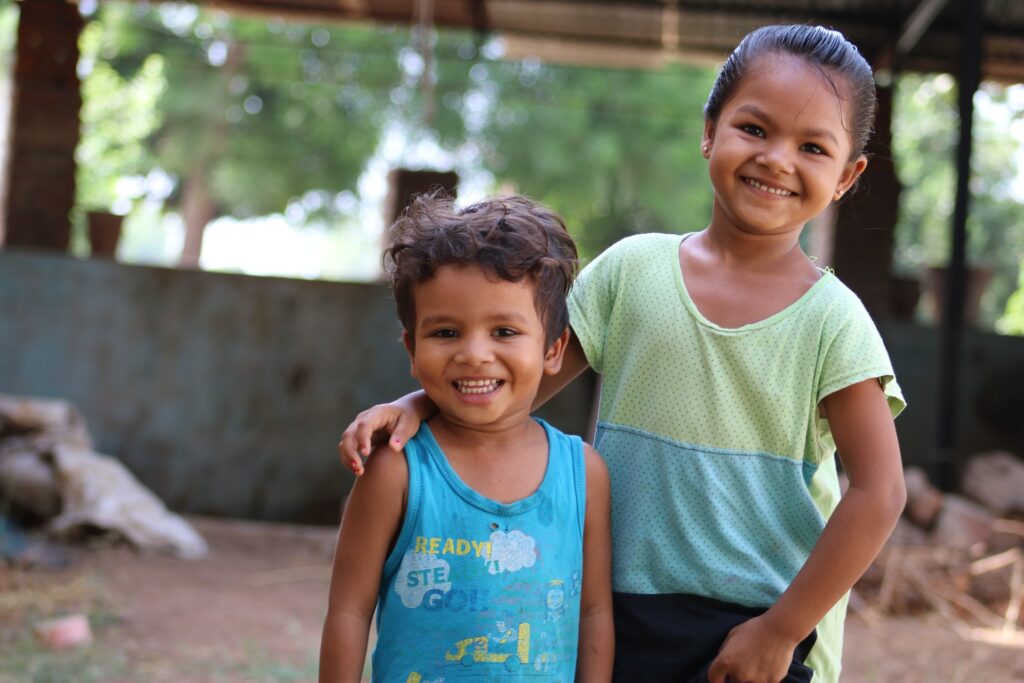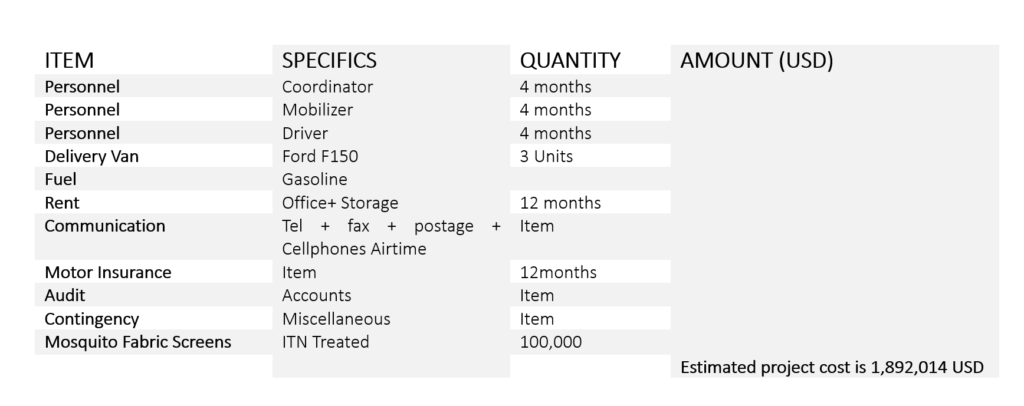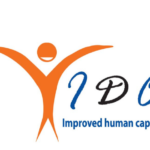
Global Solidarity Corporation. Public Charity. EIN 46-2111417. DUN 079365911. CAGE 74B24
Democratic Republic of Congo (DRC)
New Approaches for Addressing Outdoor/Residual Malaria Transmission among Refugee communities.
1. At Global Solidarity Corporation, our guiding philosophy is rooted in anticipation and prevention of crises. This is encapsulated in our motto: ‘A stitch in time.
2. D.R. Congo has over 112,000 refugees in neighboring Uganda, many of whom are now returning to their country to find a broken-down healthcare system. Malaria remains a significant threat to life especially among children and pregnant women.
3. Our focus is to fight malaria in D.R. Congo not from the doctors’ offices but from where the mosquito population thrives and propagates. We want to disrupt the chain of causation of malaria by attacking the well-known bases of mosquito families and disabling them from infecting humans in the project area. No dollar of the project budget will go into the purchase of drugs and this is what makes our approach “new.”
4. Our agents in the field have confirmed that mosquitoes breed in stagnant waters, especially ponds, pools and marshes – which can be treated to prevent mosquitoes from thriving. Some of these mosquito-breeding excavations are man-made in the course of economic activities such as clay-harvesting and brick-making to eke out a living. Our project can eventually halt these activities by offering profitable alternatives such as orchard farming and bee-keeping, among other options. All stakeholders are welcome on board and will be accorded audience.
5. Another fact. Mosquitoes bite their victims only at night, in bedrooms and never during the day on the street. We want to prevent mosquitoes from biting any person in their sleep by distributing Insecticide Treated Nets to ALL households in the project area. Every head of a household is to be registered and held accountable for the mosquito nets issued to his family and the project will ensure that the nets are not converted to fishing nets (it has happened in the past) or sold off to buy tobacco or alcohol.
6. Part of the project funding is for sensitization and mobilization. We want to equip beneficiaries with knowledge of how malaria is spread, how fatal it is and what everyone ought to do to avoid a trip to the doctor`s office. In an area where malaria has been accepted as part of life, there is need to table the statistics of fatalities for everyone to see why something has to be done by everyone.
7. Beneficiaries will be told that malaria in D.R. Congo kills far more people every year than HIV/AIDS and, therefore, must be tackled with vigor and determination at all levels. Annually, D.R. Congo loses numerous people to malaria, making it the leading killer. Moreover, malaria survivors are likely to become poor on account of lost earnings during recuperation. The country`s GDP goes down because sick people do not work or go to school. Standards of living plummet as the dependency ratio in families increases.
INNOVATION: Our idea is unconventional because we are not focusing on therapy of malaria but on root causes and spread of malaria and that`s where we want the battle to be. Halting the vector, rather than treating the disease, is what makes us unique in our approach. It will succeed because it tackles the problem from the root cause instead of dealing with the symptoms of malaria.
INVESTMENT OUTCOMES
Projected Agenda for Phase 1
1. Mobilization and sensitization of 4300 families on matters of malaria threat and how it can be prevented at household level.
2. Distribution of 100,000 Insecticide Treated fabric screens to 30,000 homesteads in the project area of Goma, Rutshuru, Masisi and Walikale in Kivu Province of Eastern D.R. Congo. Heads of households will be registered with their ID numbers and signatures after being issued mosquito screens.
3. We expect a decline in malaria-related hospital visits by especially pregnant women and children below the age of 5 who are the most vulnerable in the project area. Subcounty, county and District hospitals will avail data on malaria-related hospital visits for comparison with pre-project statistics.
| SERIAL |
WORK PLAN ACTIVITY |
ACTIVITY LENGTH (days) |
|---|---|---|
1 |
Procurement and shipping of ITN from Hong Kong to Goma
|
60
|
2 |
Mobilization and sensitization of beneficiaries
|
60
|
3 |
Distribution of Insecticide Treated Nets to families
|
90
|
4 |
Evaluation and Report Writing
|
30
|
ORGANIZATIONAL FIT
The CEO of Global Solidarity Corporation brings a wealth of experience and a deep understanding of the East African context to the organization, which can be a significant asset in implementing projects in the region.
With 21 years of experience in East Africa, including time spent in Eastern Uganda and Central Uganda, he possesses in-depth knowledge of the local cultures, communities, and challenges. This regional expertise is invaluable when planning and executing projects in the area.
His previous role as a Project Coordinator for a US-funded Greenfield Canvas Project for the disabled (1993/94), demonstrates his ability to lead and manage initiatives effectively.
Having been involved in establishing the Family of Africa NGO in Central Uganda to support displaced orphans from conflict-affected areas highlights the CEO’s commitment to social impact and his ability to create and manage organizations aimed at addressing pressing social issues.
Being a multi-lingual native of Uganda also is a significant advantage when working on projects that require effective communication and collaboration with diverse local communities. Language proficiency can facilitate better understanding and cooperation.
The CEO’s long history of volunteering and working in East Africa suggests a strong commitment to making a positive difference in the region. This commitment has inspired and motivated the team at Global Solidarity Corporation and attracted like-minded individuals and partners.
RISK AND CHALLENGES
One of the foremost challenges confronting us is the mobilization of additional funding to expand our project’s scope beyond the distribution of mosquito nets. Our aim is to encompass comprehensive vector control measures that address mosquito breeding grounds in swamps and stagnant waters/ponds. A notable characteristic of these aquatic habitats is their human-made origin, stemming from clay excavation for the construction industry. The attendant environmental degradation presents a formidable hurdle that demands innovative solutions, primarily revolving around the identification and promotion of alternative livelihoods, such as poultry farming, bee-keeping, and orchard cultivation, as integral components of our project.
The intricacy of this challenge lies in the delicate balance between addressing environmental concerns and safeguarding the livelihoods of vulnerable villagers. Any intervention that jeopardizes the income streams of these struggling communities runs the risk of generating resentment and even sabotage, irrespective of the most well-intentioned project objectives. Therefore, it becomes imperative to harmonize vector control initiatives with income diversification strategies, ensuring that the transition away from environmentally harmful activities is accompanied by viable and culturally relevant alternatives.
Moreover, the contentious use of the chemical DDT for vector control has not achieved widespread acceptance within the project area. This adds an additional layer of complexity to our efforts. It underscores the importance of engaging in thorough community outreach, education, and advocacy to promote alternative, environmentally friendly vector control methods that resonate with local preferences and sensitivities. By carefully navigating these multifaceted challenges, we can foster a more sustainable and harmonious approach to vector control while addressing the intertwined issues of public health and environmental protection.


- Global Solidarity Corporation
- [email protected]
- Choose your favourite cause
- Register to our website !
- Donate the amount you like
- Stay tuned about cause
OUR PARTNERS
NEWSLETTER
© Copyright Developer Reyaz

Leave a Reply